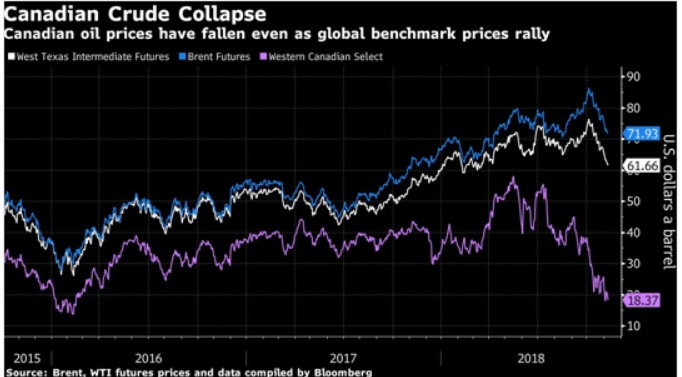The Oil Price Collapse Will Hit Canada
Revised data from Statistics Canada confirmed that Canada’s economy suffered even worse than previously reported from the massive decline in oil prices that began in 2014. The agency lowered the national growth figure to 1.1 percent in 2016, compared with 1.4 percent previously, and to 0.7 percent in 2015, from 1 percent. The collapse of oil prices in 2014 was the prime motive behind the Bank of Canada lowering the bank rate to cushion the blow to the Canadian economy.
Historically, Western Canadian Select (WCS) is priced anywhere from US$10- $15 /bbl lower than West Texas Intermediate (WTI). Today, the gap between the two sources of oil producers stands at $45/bbl. This yawning gap will cost Albertan oil producers considerable foregone revenues and profits and will lead, ultimately, to cancelled investment projects. Industry analysts offer several explanations, some temporary and some long-term, to explain the price gap. At the top of the list is the normal price discount to account for the higher cost of refining Canadian oil from tar sands (roughly $10-15/bb). Next in line is the problem of insufficient pipeline capacity to deliver oil on a timely basis (another $10-15/bbl). A wrinkle just introduced is the upgraded fuel standards for the marine shipping industry which target heavy sour crudes such as that produced in Alberta (price effect is indeterminate). Finally, the United States is producing record levels of oil production, especially from non-conventional sources, that more than satisfy domestic demand, giving considerable competition to Canadian producers.

The collapse in the external price of Canadian oil is already been felt in the oil patch. Majors such as Royal Dutch Shell and ConocoPhillips are selling oil-sands assets. Canadian producers are cutting back on production in line with reduced demand. The TSX oil index is off about 15 per cent from its September close.
The Bank of Canada[1] has built into its forecasting model oil price assumptions that are no longer relevant to support its position that the economy is on a solid footing. The Bank forecasts rest on the assumption that Brent, WTI and WCS will average $80, $70 and $35 a barrel, respectively. No longer can the Bank’s forecast for energy prices and exports hold up given the widening spread between world prices and WCS. Moreover, this price weakness will in short order be felt in Alberta and the rest of the country. The collapse of oil prices in 2014 forced the Bank of Canada to lower its bank rate to cushion the negative impact on Alberta and the rest of Canada. It is quite legitimate to call into question the Bank’s intention to raise rates continually while Canadian oil prices remain in a deep slump.
[1] Bank of Canada, Monetary Policy Report, October, 2018




Canada has to export oil go the Pacific Ocean, it would seem. Relying solely on the USA seems to be unreliable, prof.